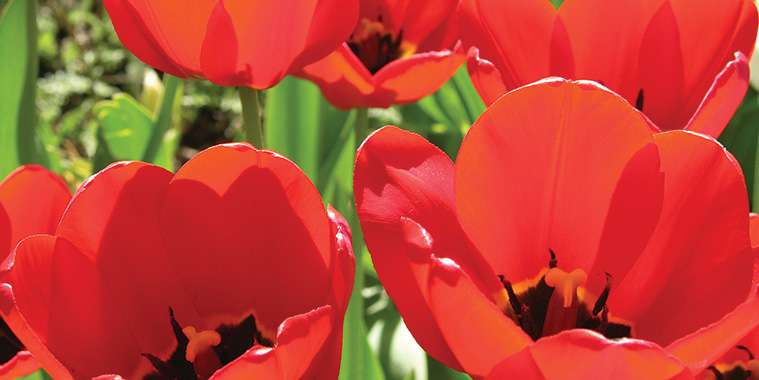By Dorothy Dobbie
Drifts of golden daffodils, clouds of fragrant hyacinth, row upon row of brilliant tulips; this is our dream of springtime, the brightness of the spring bulbs freshening winter weary eyes with their electrifying colours.
Our labour of hope starts in fall, when we place the bulbs, root down in the soil, two to three times deeper than their height. If we are kind, we put a handful of bone meal in the planting hole and we snuggle our bulbs into the soil in groups of three, five or luxurious seven. Then we wait for the snow to melt, for the first green tips to emerge from the barren ground, for the first early buds to appear.
As the season progresses, other plants emerge, stealing the show from our bulb beauties, which are beginning to fade as the days grow warmer. Spring bulbs resent heat and will stay fresh much longer in a late, cool spring.
Once the blossoms have dropped their petals, the flower stalk can be cut, but don’t touch the leaves, which are busy manufacturing the sugars needed to nourish the bulbs for next year’s display.
As the flowers fade, the leaves will get larger and lusher. Then they will begin to wilt and turn yellow. This is the sign that their work is done. If you leave them in place now, they will eventually turn brown, then melt into the soil, but most of us prefer to tidy and pull them away from the mother bulb (if they come away easily, this is a sure sign that they are finished photosynthesizing) and dispose of them.
Don’t worry about planting spring bulbs under trees. Even if they are sun-lovers, they will bloom before the trees leaf out and since most bulbs enjoy a drier soil, they won’t mind competing with the tree roots. Avoid planting them in areas that are the last to dry out after the snow melt. The soil will be soggy and the bulbs may rot.
Chances are if you are a new gardener, you didn’t check to see if the bulb you planted was early, mid or late blooming and the early bloomers may emerge as soon as the sun gets strong enough to melt the surrounding snow. They may pop up before the last snowfall or cold spell. Don’t worry too much about them. Many will regenerate.
Choose tulips carefully for our climate. The huge Darwins look lovely the first year, but their return rate is very low as it is for many of the other exotic hybrids. Plant them without expectation of repeat performances. However, there are many species varieties that will reward you year after year. They are shorter and have smaller flowers than the hybrids, but they are far more reliable.
Hyacinths are lovely but are again marginal in our climate. I would choose a south-facing foundation location where the soil is somewhat warmed by the house. The little grape hyacinths are another matter — they are very loyal, coming back year after year and making a lovely show against a planting of yellow daffodils.
Daffodils are quite hardy here, especially the tried and true types such as King Alfred. They will happily reproduce, the clumps becoming larger and larger. After a few years, it is a good idea to split them.
Alliums are another good bet and there are many varieties, from small drumstick plants, to larger, very showy types. They range in colour from blue to
almost magenta and their glove shapes add eye-catching variety to the garden.
And if you forgot to plant bulbs last fall and are having bulb envy this spring, why not run out to the garden centre and buy some gladiola, calla lilies, dahlias, freesia, crocosmia . . . All are grown as annuals, but you can dig up their bulbs in fall and save them in a cool, dry place over winter.
Dorothy Dobbie is the publisher of Manitoba Gardener.



